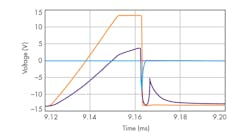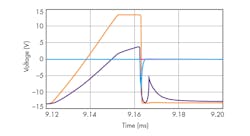My article about voltage-to-frequency converters had a figure that showed the waveform on the base of a unijunction transistor (Fig. 1). This was a PSpice waveform generated by OrCAD 9. After the UJT base reaches 4 V, the base impedance collapses and the base voltage drops precipitously. The surrounding circuitry draws the base down to −13 V. That’s all good and well, but there’s a funny spike in the waveform after the voltage collapse. About 6 µs after the voltage collapse, the waveform rises back up to −5 V. The waveform then does a nice exponential decrease back down to −13 V.
1. This Spice simulation has a blue trace that shows the base of a unijunction transistor operating as an oscillator. The waveform peaks after it rapidly falls, but that doesn’t matter in the operation of the circuit. Not only that, the peak might just be a Spice artifact.
At the time I wondered if this was a case of Spice lying, the way Bob Pease said it does. I can see a complex circuit with bad models giving bad output. When Spice was invented at UC Berkeley in 1968, one of the things they worked very hard on was making models for transistors and diodes. Later work improved those models with behavior over temperature. With the 2N2646 UJT being a rather obscure and obsolete part, it was hard to say if there were any good models available for the transistor.
Perhaps I will find some of that part on eBay and build up this circuit. I suspect the waveform will have the same little peak in it like that in the Spice simulation. That peak might bother you the way it bothered me. Engineers hate a mystery; we are a fundamentally curious breed. What is important to remember is that that little peak does not matter to the performance of the circuit. No matter how much it bothers you, as long as it does not damage anything or cause electromagnetic interference (EMI), it’s a perfectly good circuit you can send to production.

